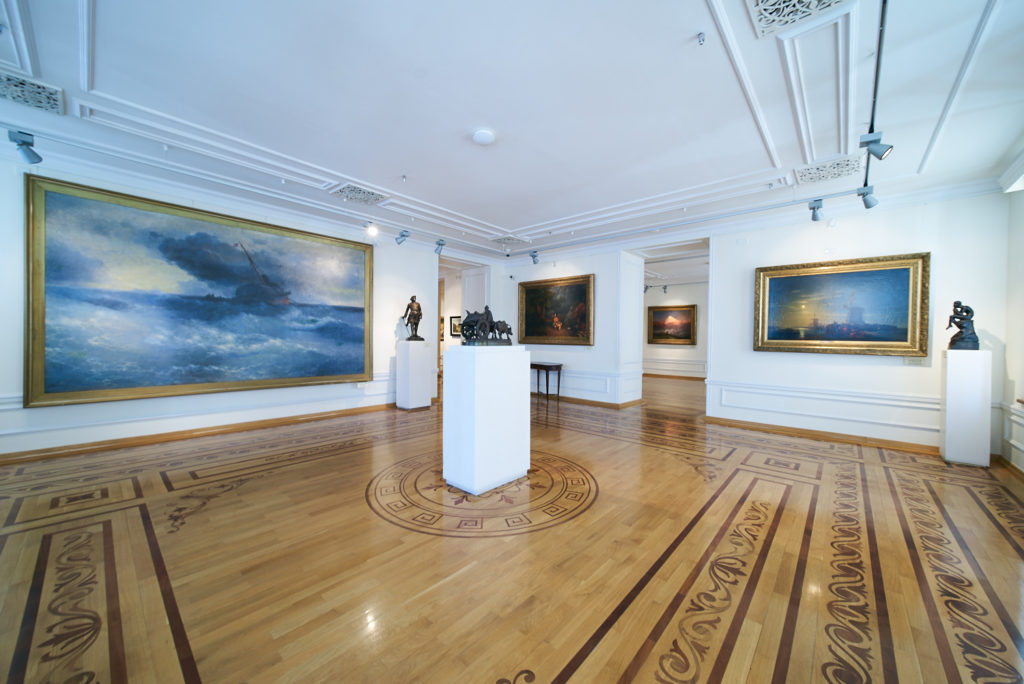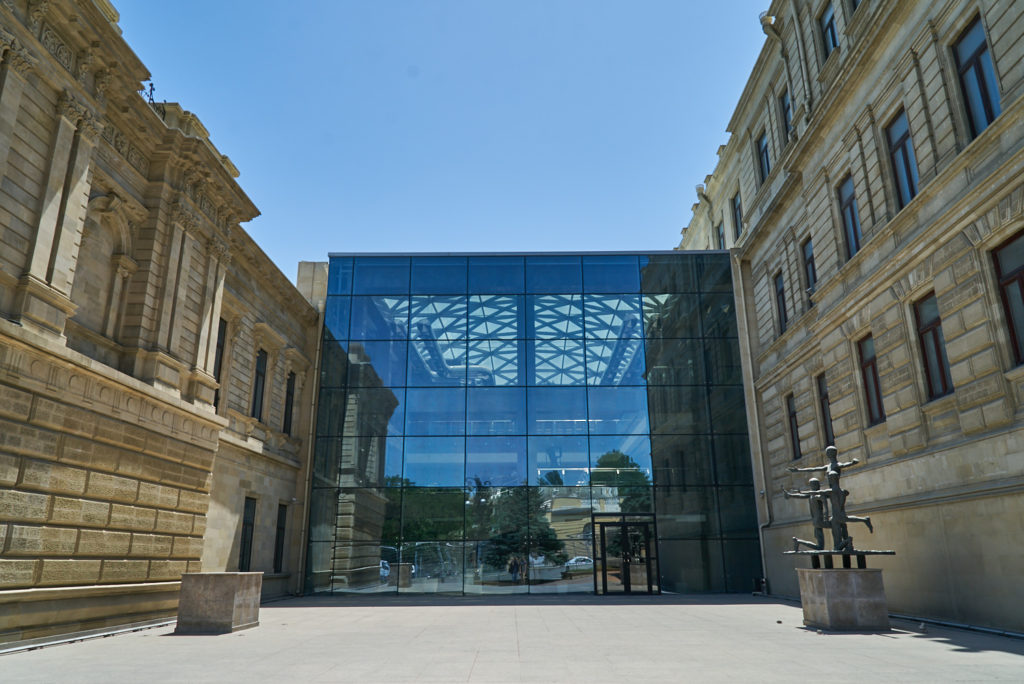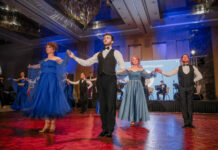Azeri Observer interviewed Chingiz Farzaliyev, Director of Azerbaijan’s National Museum of Art
By STALO KOUALI
AZERI OBSERVER STAFF WRITER
Question: Please tell us about the history of Azerbaijan’s National Museum of Art and its distinguishing features?
Answer: It should be noted that the decision to establish a museum was approved in 1936. It was originally part of the Fine Arts department of the Azerbaijan State Museum which opened in 1920. I think that the development of all museum-related work in Azerbaijan begins from this history. As museum-related work grew in Azerbaijan, the necessity of dividing into separate museums with their own specificity and direction arose.
The National Museum of Art of the Republic has been formed over decades. It has moved from one building to another. Collections used to be distributed among several locations. It wasn’t until 1951, the museum established itself in the building known as the De Bour Mansion at 9 Chkalova street (formerly Sadovaya, present-day Niyazi Str.). After the breakup of the Soviet Union, the government issued a resolution extending the National Museum stretched into the neighboring building, the beautiful former Mariinsky Girls Gymnasium built in 1885. We can say that the cultural history of the Republic became complete – Art within Art. The artistic values of our fund are demonstrated in halls of buildings which are themselves treasured examples of republican architecture, lending the museum an extra aura of prestige.
Among our museum’s distinctive features are that it is the foremost museum of the country. It is the calling card of the amazing characteristic of the Azerbaijani people – tolerance. Although this concept didn’t exist in ancient times, there have always been relations with the cultural traditions of other nations based on the principles of neighborliness and mutual respect. Today, this concept is reflected in the collection which contains works of art from all over the world placed amongst works reflecting our cultural history. The development of the latter is also a distinctive feature of our museum. Azerbaijani Art through the Millenniums is a large-scale exposition telling the story of the independent development of art in Azerbaijan, the transformation of the consciousness and understanding of surrounding world of the Azerbaijani people, that was reflected in the unique exhibits, reflected in unique works of art gathered across the years from the different regions of the republic. I should confess that I am particularly proud of this exhibit. I still remember the incredible number of kilometers of road that I had to drive in order to expand this collection. I could write an interesting adventure novel.
Describing the other distinctive features of our museum would take a lot of time, so instead I’ll just offer a picture of the scale of our Fund – more than 18,000 pieces! The permanent exposition is a journey through time and distance. Ancient Egypt exists alongside Western art, ancient Roman neighbors Russian art, from ancient Greece you can travel to medieval France, etc. All this takes place within the walls of one museum.
The other distinctive feature that I cannot fail to mention is our team: from the representatives of the scientific departments, who are high-level specialists, to the technical staff. These are the people whose efforts create the atmosphere that greets visitors from the moment they open the doors to our museum.
Q.: Azerbaijan has been through a lot of changes since the establishment of the Azerbaijan National Museum of Art. What are the biggest changes that the museum, the country’s largest, has undergone since its opening?
A.: Some of the changes I have already mentioned. I can add that one of the biggest changes is addition of the middle building between the two original buildings of our museum. The new building made it so the museum, previously in two separate buildings, became a single entity. The new intermediate space also became an additional exhibition area.
The middle building was fondly nicknamed “The Glass” by many people (including our staff), evidence that people approved of its hi-tech architecture. It is a reflection of modernity. The National Museum has been expanding contacts with colleagues in other countries year by year, more so in the last two decades. We learned to correctly use the freedom that became possible when Azerbaijan gained independence. No, do not think that everything was wonderful from the beginning. The museum, along with the entire Republic passed through many stages: from complete oblivion to today’s current state. The most important thing is that throughout its ups and downs, it never lost a single work of art, which in itself is a miracle! There is no other word for it. One need only recall the troubled times when art was perceived as optional or even alien to the national identity. I thank God that the collection did not suffer any loss. Something else has happened. In difficult times, when people’s need to survive was in the first and foremost, cultural education was no longer in the front of our minds. It is only today, after several generations, that we have returned this integral part of development to our people, without which there would be neither people nor the state. My firm belief is that for the last several years the museum has become a popular venue to visit for youngsters – a major achievement of the museum’s promotional activities!
I have always stressed my conviction and will continue to do so, that the most important priorities for any museum are and will be the storage and promotion of works of art. Art is part of the culture of people, irrespective of the museum’s establishment date. It is always young. Despite the historical gray some of our works acquire, the main point is their fullness of meaning and message towards the future. It is the same as what history has created for the present. The National Museum of Art achieves this by constantly replenishing our collection with works by contemporary artists. We have proven that our museum is alive and evolving. And this is also a big change.

Q.: How does it feel to be the ‘one behind the wheel’ of the foremost national museum of the republic?
A.: To be the ‘one behind the wheel’ consists of two important components – doing it responsibly and doing it proudly.
I was thinking about these responsibilities when I decided to consent to being the director of the Azerbaijan National Museum of Art. I carefully weighed the decision for several months. I am a perfectionist, and I understood that in as the head of such a museum I would be putting even more pressure on myself. However, to shy away from challenges is not in my character. To be honest I liked this proposal. It was a new direction in my professional work. A month after my appointment as director, I could not imagine myself outside the walls of the National Museum. Even now I admit to still being filled with great love and admiration for the museum. I had to overcome many difficulties, but mostly I think, has it already been 10 years?
In some cases, it was possible to start everything from scratch, completely starting anew. Azerbaijani Art through the Millenniums is one such example. But at the time of my accession, there was already a staff with an established perception of work responsibilities with whom it was necessary to build relationships. Not everyone took the innovations and changes well.
Only the most devoted and professional of the museum employees have remained working in the museum. In one of my previous interviews, I compared myself to a gardener who knows every flower and plant in his garden. This museum is first and foremost the result of the labor everyone working in it. Without complete their dedication the works of art in the museum’s collection would never be fully appreciated for their greatness and beauty. So, I share this responsibility with the whole team, except in a slightly higher degree, as I am the head gardener in charge of every garden bed.
Looking back, I rightly feel genuine pride in the results achieved over my seven as Director of the Azerbaijan National Art Museum. This feeling is shared by all who have worked with me on this effort. Many of our employees can be called ‘fighters of the invisible front.’ This is the correct approach for their professional duties; nothing should detract from the main objective that museums are created for – to teach, enlighten, educate, and give aesthetic pleasure.
Q.: You yourself are an esteemed artist. Do you continue to paint? If so, how has your role as the director of the National Museum influenced your work?
A.: Regarding remaining a practicing artist, I knew that once I started the duties as Head of the National Museum, this page of my life would be turned upside down. No, my communication with the canvas was not completely interrupted, but this is more the need of my heart and soul, for myself, not for exhibition purposes. A true artist cannot stop creating works of art. Otherwise, he can be called dead, and I love to live! Painting is an integral part of me, and therefore has not gone anywhere, it has just slightly given in to the more dominating role of my directorship. I do not know how to do something with only half effort. If I paint, then it is with full dedication. My current activity is directly related to creativity. I have continued to edit and publish countless books and textbooks of research, an activity I began during my tenure at the Institute of Arts. I continue to be engaged in this sort of creativity. It cannot be concluded within the framework of ‘one canvas’ of artistic endeavor. It is multifaceted, and that is why it is so interesting and fascinating.

Q.: Can you tell us a little bit about the collection housed in Azerbaijan National Museum of Art? What are some of the rare and valuable pieces housed in the museum?
A.: As I have already mentioned, we continue to expand our collection of Azerbaijani Art through the Millenniums. It is displayed in even greater splendor after the completion of the state supported restoration of the second museum building museum. The second building showcases world art as well as Russian art, and the existing permanent exposition expanded with works that were in our storage rooms. In the existing building, the exhibition area devoted entirely to the rich cultural heritage of Azerbaijan. Within the walls of our museum there are many exhibitions of revered artists of Azerbaijani culture. But with pleasure, we also feature works of modern and young artists who have earned their space in the esteemed halls of the National Museum. Being exhibited in the National Museum is an indicator of the degree of significance their artistic work carries. I cannot single out or appreciate any work or artist more than the others. Each of the items included in the National Museum’s Storage Fund is unique and valuable. In our collection, there are unique items of Japanese and Chinese art, works of Russian artists, including icon painters, works of the avant-garde movement, and a recent exhibition of French art. Our funs include many rarities and valuables.
Q.: How many visitors come to the museum each year? What challenges does the museum face in attracting visitors? What is the museum doing to bring in more visitors and engage the community in the arts?
A.: There is a certain rationale behind attracting visitors, especially in light of the financial component. However, we are not a public catering company or an entertainment center. It is clear that the more people who come to us, the more money the museum will earn. But, it is more important for us to create an atmosphere that encourages people to become permanent friends and regular visitors rather than merely increase the number of visitors. The museum’s permanent friends did not abandon or betray their love of art even in the most difficult years of the museum’s life. There was a period when art was considered unnecessary compared to the other pressing problems facing society. The society that inhabited the capital city also changed. A million people suddenly lost everything and the war had such a strong psychological effect that it was impossible for most to even think about visiting a museum. It was only after time realized its medicinal force that man could return to his universal human needs and once again feel the importance of those ‘unnecessary things,’ including visiting museums. Broken souls and hearts are treated with beauty. People are drawn to art. Fortunately, over time, the problems with attracting visitors were left in the past. No, I cannot say that the museum halls are so full you cannot get through, but this is not what we are striving for. The museum should preserve the atmosphere of a temple of art, and therefore it cannot be a courtyard. The most important thing is for a person to be able to come here to rest the eyes, heart, or soul, or to search for answers or make important decisions. Believe me, when you are faced with a certain dilemma, go to the museum, wander through its halls, and stand in front of the works that resonate in your soul. The beauty and harmony will give you direction, and after leaving the museum, you will find the right decision. This is the magic of art, proven by time. I use this recipe. To walk through the silence of museum halls is the need of my inner world. To meditate among works of art is the enjoyment of the mind. I want to believe that my personal example will be true for others. I hope that even those who had never even thought to cross the threshold of a museum, will come to our museum and after feeling this magic, will become regular visitors.
My strongest conviction is that one should be brought to museums from a very young age. Let kids, before they even know how to talk, being their lives among works of art. Children’s perception of the world around them is unique. It is absolutely pure and unbiased. Parents abroad visit museums with babies, walking among works of art dating back to more than one hundred years. This is a continuity of generations. No matter how difficult times were in world history, people survived and preserved themselves by turning to beauty. There is no other way. The psychological state of the nation and its citizens directly depends on cultural education. And this is not conceivable without visits to museums. We are doing everything in our power to promote the importance of art from a young age. Many programs directed by the National Museum of the Republic are aimed at young citizens of the country.

Q.: Which prospective projects are you planning for the enjoyment of our citizens and guests of our city? What exhibitions would you like to bring to Azerbaijan?
A.: Exhibition projects including joint projects with our foreign colleagues require thorough analysis of demand and significance. Creating an exposition demands many contributions and finances, so one must first understand what people will be interested in at this period of time. The museum cannot exist beyond the life of the state and its citizens. We are the bearers of memory, but this doesn’t mean that the museum is something motionless in time and space. I always emphasize that our purpose includes the education of the future citizens of our country. We must provide the maximal opportunity for their acquaintance with the development of our republic through out the centuries. We must show that the culture of Azerbaijan is inseparably linked with world culture. In recent years, we initiated a series of exhibitions with clear attachments to definite countries. The Art of France exhibition was created from our own collection. Its positive reception made us understand that we made the right selection. .
Works of art are probably the greatest time travelers to the past and present. Many artistic works acquire permanent residence at a distance from their native land, so from time to time they are requested for specific projects. Our museum participates in these projects like any other museum. But organizing such projects is very complex. Attracting any exhibition to Azerbaijan is a multilevel task demanding support from many structures, including the state. The stars must align. If it becomes possible, we would gladly present various exhibitions from abroad to visitors.
Q.: Director Chingiz Farzaliev, you have genuinely piqued our interest, not only because of your role as the Director of the National Museum of Art, but moreover, because of your importance and standing within the art world. You are a professor in the Azerbaijan Academy of Art, an honored member of the Russian Academy of Art, an honored professor of the Uzbekistan Academy of Art, and the author of monumental research publications on the arts. One can name a long list of your achievements and awards. It would be interesting to know which of your achievements you yourself find the most remarkable.
A.: Each of these are important stages of my activity. The most important is my assignment to the National Museum. I accept all these ranks and regalia on behalf of the museum and only in the capacity of a representative of Azerbaijan. Maybe each of these presented awards has its own meaning, but in my eyes, they are assessments of Azerbaijan’s service to art and its contribution to world culture on behalf of its son – Chingiz Farzaliyev – who strived for the elevation of his native land and saw in it his destination.
Because generally the recognition of each country is associated with names of its people, Azerbaijan is known to world thanks to its children who were able to step over its borders and represent it in its full cultural beauty and variety through their work. I may repeat many times that art speaks all languages and is understandable without translation. I can give my awards as an example. These accomplishments must be perceived as whole, it is a single world of art and creative work to which I have devoted my life.
Q.: If there were a flood and you had the chance to save one painting, what painting would you save and why?
A.: May God protect us from all catastrophes! I will answer in a few words– I will do everything in my power to save each work of art from our collection of many thousands. Only after that would leave my ship. It could not be otherwise.




















